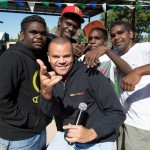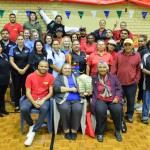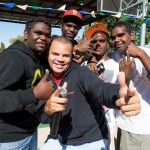What is Breaking, Rap and Hip-Hop?
Breaking is an acrobatic style of competitive dancing comprised of a number of discrete, energetically choreographed moves and routines. Breaking originated in the black and Hispanic street cultures of New York City’s South Bronx and Harlem boroughs in the early 1970s.
One of the reasons breaking became – and has remained – so popular is because it is both performative and competitive. Breaking is also athletically and acrobatically demanding – in other words it’s enjoyable to watch – so it’s little wonder it became a staple of New York’s ghetto culture.
As breaking’s popularity rose throughout the 1970s, so too did boredom, drugs and violence gradually give way to physical artistry and creative expression. Breaking became a very elaborate combination of coordination, technique, drive and pure strength.
When the disc jockeys that supplied the music for breaking began talking over their records, the phenomenon of rapping was born. Arguably the first rap track ever produced was by the Johns Hopkins-educated poet/novelist, singer, jazz pianist and political activist Gil Scott-Heron, whose 1974 classic “The Revolution Will Not Be Televised” is now considered an American classic.
Afrika Bambaataa, also known as the Godfather of Hip-Hop, was instrumental in recognising and articulating the culture that grew up around breaking and the music it thrived on. He coined the overarching term ‘hip-hop’, which was a way of life that encompassed the elements of breaking, DJing, MCing (rapping), graffiti (writing as expression) and most importantly, knowledge.
Always a positive force in his Bronx community, Afrika used breaking and hip-hop as a means of encouraging young urban African-Americans to learn more about their culture, take pride in themselves and respect each other.
Today, breaking and hip-hop are truly worldwide in their appeal. People rap in dozens of languages and do the ‘windmill’ et al in all four corners of the world, including Australia. Many young Aboriginal and Torres Strait Islander people enjoy listening to hip-hop, rhyming on the mike themselves, and testing each others’ acrobatic abilities on a large piece of cardboard thrown on the ground.
By encouraging personal development, creative expression and physical fitness, breaking and hip-hop are an excellent means of motivating Indigenous young people to believe in themselves, learn about and respect their culture, and fully realise their potential. At the 3 on 3, Aboriginal cultural themes and moves are integrated into contemporary music and dance.
The hip-hop and breakdancing challenge runs alongside the basketball challenge and is presented by Brother Blak and Monkey Mark (two well-known Aboriginal hip-hoppers), who also run a workshop.






Comments are closed.